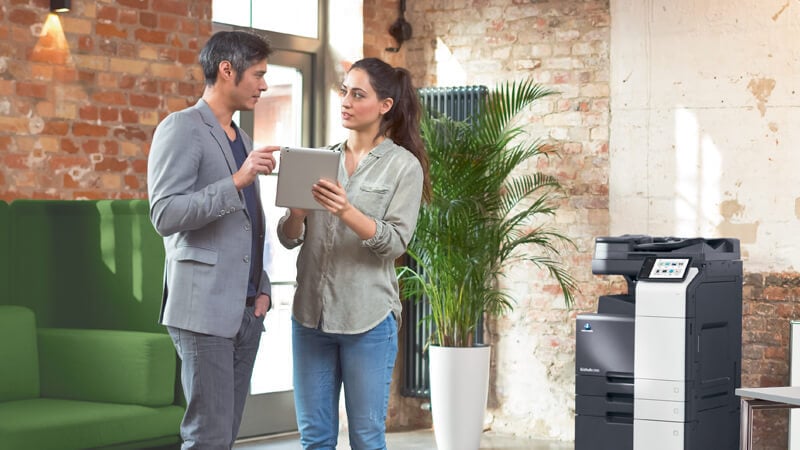Office copy rooms used offset presses not too long ago. After a day of squeezing tubes of ink onto rollers, we'd all have a greater appreciation for today's advanced printers and copier machines.
Although office print solutions have evolved, they still share one main ingredient with their predecessors: paper.
There are some basic paper properties that anyone who has ever loaded an empty printer paper tray should learn. These characteristics include:
- Curl
- Weight
- Grain
- Caliper
- Moisture content
Why are these things relevant to you? It's simple — understanding these factors is the key to producing high-quality print jobs, with the lowest instance of jamming or malfunction.
Let’s break down each factor contributing to paper jams and review a few best practices to enable better paper management and ensure your printers and copiers consistently function at peak performance.
1. Paper Curl
Paper tends to bend in one direction. Like a long piece of lumber or a sheet of plywood, printer paper has a natural bow. This paper characteristic is commonly referred to as crowning. Open a ream of paper and cup your fingers loosely under the middle, and you will notice the ends sag. Flip it over, do it again, and there will be a difference in the amount of sag. Whichever side produces the most sag is the side with the crown.
If possible, load your paper tray to ensure that printing is done on the crown side. Loading your paper on the crown side will, to some extent, counteract the curling produced by printers as the rollers heat and press toner into the paper. Reducing curl is essential because paper curl is a major cause of paper jams.
2. Paper Weight
Paper weight is expressed both in grams per square meter (g/m2), and in pounds per 500 sheets of a particular basis size, usually 17” x 22” for copy paper. Thus, a ream of multi-purpose copy paper may be designated at a weight of both 20 lbs and 75 grams. The higher quality paper might be set at 28 lbs and 105 g/m2.
Because different paper types use different sized basis sheets, the pound system (used only in North America) is not as exact as the metric system in comparing weights of varying paper types. For this reason, the setting for paper weight on most multifunction printers is g/m2. This setting is important because entering the paper weight improperly can cause paper jamming.
3. Paper Grain
Going against the grain is not just a cliché when it comes to printer paper. Just like wood, paper always tears straighter with the grain. Tearing those coupons out of the newspaper is an excellent way to experience paper grain. And, just like the newspaper, most 8.5”x11” copy paper is long grain, meaning the grain runs parallel to the long side.
Sometimes, larger sheets of copy paper are short grain. Reading the labeling and packaging is a quick and easy way to determine the grain direction. The second number in the paper’s dimensions specifies the grain. For example, 11”x17” is long grain, and 17”x11" is short grain.
Grain awareness in printing is critical because color documents folded along the grain will have less toner crack along the fold, resulting in a cleaner, more professional-looking finished product.
4. Paper Caliper
Caliper (thickness) depends on weight and pressing during manufacturing. Thicker paper is generally stiffer and rougher than thin paper. Caliper is expressed in mils (thousandths of an inch) or microns (millionths of a meter).
Caliper is an important paper property because a thin paper with low stiffness can wrinkle and cause a printer or copier to jam. However, thick, stiff paper can also cause jamming because it cannot bend easily.
5. Moisture Content
High moisture content and curling go hand in hand. Paper with a moisture content above 5.3% is too wet. Then again, if printer paper is too dry, it may cause static electricity, leading to jams and misfeeds. Ideal printing paper moisture content is somewhere between 4 and 5%.
Since moisture content is an essential component of paper jams, careful consideration is required when storing printer paper. Moisture-proof wrappers help keep paper from absorbing moisture or drying out in storage. If a business uses opened reams of paper, it must do so promptly.
Also, consider recycling those half-used reams of mystery paper sitting around in your storage closet. We've all got one or two of these sitting around somewhere. They will be much more likely to create a misfeed or paper jam if you print on them. A cost-effective and sustainable solution is to have them converted into recycled notepads, which you can give to employees, clients, or partners to use as scratch paper.
Avoid Paper Jams and Improve Uptime with a Reliable Managed Print Service
With clear insights on basic paper properties, businesses can avoid and reduce the frequency of paper jams in their office printers and copiers, improving uptime and maximizing productivity. However, like all technology, malfunctions and issues will occur occasionally.
When a business does experience a misfeed or jam, the most important thing to do is to remain level-headed and rational. These issues tend to happen at the most inopportune times. While frustration is the natural response, staying calm and slowly clearing the jam is the best course of action. If you let the jam get the best of you and try to pull it out too quickly, you risk leaving tiny, torn pieces of paper stuck in your device, which can lead to more costly problems.
Fortunately, businesses don’t have to solve these issues alone. When in doubt, businesses can rely on their managed print service provider for proactive printer fleet management and comprehensive 24/7 support, helping to resolve printing problems before they arise.
Editor’s Note: This post was originally published on March 25, 2014, and has been updated for accuracy and current best practices.






